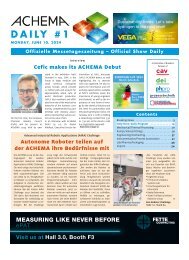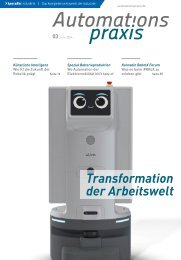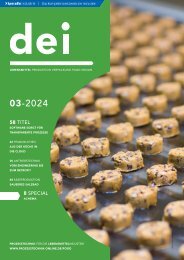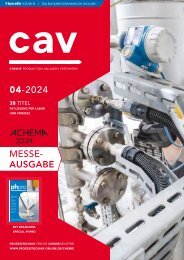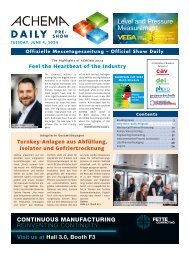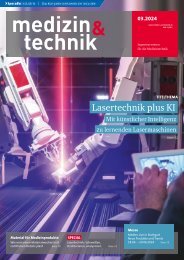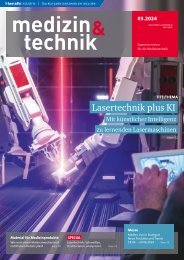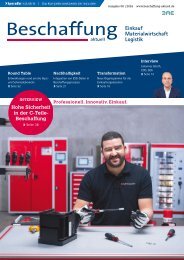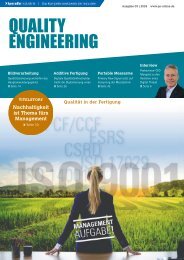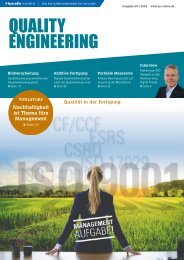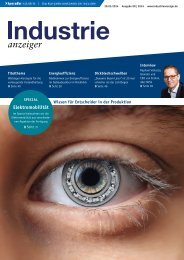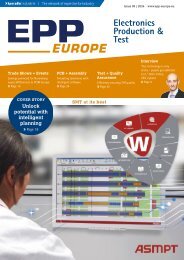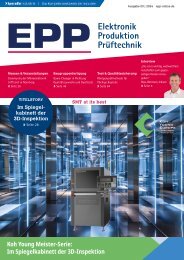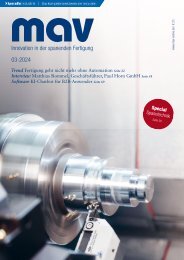cpp – Process technology for the chemical industry 01.2019
The journal cpp - Process technology for the chemical industry reports about processes, plants, apparatus and components for the chemical and pharmaceutical industry. Further topics are IT technologies, industry 4.0, digital production, MSR and automation technology and process analysis technology. The content spectrum is rounded off by explosion protection, plant safety, occupational health and safety, maintenance, site management and energy management.
The journal cpp - Process technology for the chemical industry reports about processes, plants, apparatus and components for the chemical and pharmaceutical industry. Further topics are IT technologies, industry 4.0, digital production, MSR and automation technology and process analysis technology. The content spectrum is rounded off by explosion protection, plant safety, occupational health and safety, maintenance, site management and energy management.
Create successful ePaper yourself
Turn your PDF publications into a flip-book with our unique Google optimized e-Paper software.
need to be replaced after 15,000 operating<br />
hours.<br />
Many processes and laboratories must be<br />
kept oil-free to avoid contamination of <strong>the</strong><br />
products <strong>–</strong> ano<strong>the</strong>r strong argument in favour<br />
of chemistry diaphragm pumps. They<br />
are dry-running and require nei<strong>the</strong>r operating<br />
nor cooling fluids, and <strong>the</strong>y also operate<br />
completely oil-free without any abrasion.<br />
This guarantees a dry, clean vacuum and at<br />
<strong>the</strong> same time reduces operating costs, since<br />
no consumption or disposal of consumables<br />
occurs.<br />
For protection against particles and condensate<br />
droplets, chemistry diaphragm vacuum<br />
pumps can be equipped with an inlet catch<br />
pot. An emission condenser is used to recondensate<br />
<strong>the</strong> vapours at <strong>the</strong> pump exhaust.<br />
Solvent recovery rates close to 100 %<br />
can be realised in this way, keeping both<br />
production sites and <strong>the</strong> environment clean.<br />
Precisely controlled vacuum<br />
Rotary evaporation and many o<strong>the</strong>r processes<br />
require that <strong>the</strong> vacuum is controlled<br />
as precisely as possible. Speed-controlled<br />
diaphragm pumps like <strong>the</strong> Vario series<br />
achieve this precision automatically by adjusting<br />
<strong>the</strong> pump’s motor speed. This results<br />
in fewer strokes per minute, significantly reducing<br />
wear and tear and extending <strong>the</strong> service<br />
intervals accordingly.<br />
As a result, Vario pumps are nearly mainte -<br />
nance-free in many applications. Evaporation<br />
rates are maximised due to <strong>the</strong> hysteresis-free<br />
pressure control when compared<br />
with conventional, two-point control using<br />
solenoid valves. <strong>Process</strong> times are consequently<br />
up to 30 % shorter. Energy consumption<br />
and thus operating costs can simultaneously<br />
be reduced by up to 90 % depending<br />
on <strong>the</strong> process in question. While<br />
precise vacuum control is paramount, userfriendliness<br />
and ease of use are becoming<br />
more and more important. Vacuu-Select, <strong>the</strong><br />
common controller on all Vario diaphragm<br />
pumps, sets a benchmark <strong>for</strong> straight<strong>for</strong>ward<br />
and efficient operation: simply choose<br />
and start <strong>the</strong> desired application on a stateof-<strong>the</strong>-art<br />
touch display and let <strong>the</strong> controller<br />
execute <strong>the</strong> vacuum process all <strong>the</strong><br />
way through. In case of solvent evaporation,<br />
Vacuu-Select automatically detects <strong>the</strong> boiling<br />
point and adapts <strong>the</strong> pressure continuously<br />
as necessary. Needless to say, <strong>the</strong> desired<br />
vacuum and o<strong>the</strong>r parameters are<br />
readily combinable in custom applications.<br />
Only <strong>chemical</strong> resistant materials are used<br />
in <strong>the</strong> wetted area of chemistry diaphragm<br />
pumps<br />
From small to large<br />
Vacuubrand offers a comprehensive range of<br />
chemistry diaphragm pumps with Vario<br />
control. Typical applications such as rotary<br />
evaporation are covered along with supplies<br />
to local vacuum networks, kilo labs and<br />
mini plants. Even high boiling solvents can<br />
be easily evaporated at low temperatures<br />
using pumps with ultimate pressures of less<br />
than 1 mbar. Pumping speeds up to 30 m 3 /h<br />
are possible with large chemistry diaphragm<br />
pumps (maximum pumping speed:<br />
20 m 3 /h) and Duo pumping units. In <strong>the</strong><br />
latter case, <strong>the</strong> speed of two individual<br />
pumps is synchronously controlled and precisely<br />
adjusted to <strong>the</strong> vacuum requirement.<br />
For many applications <strong>–</strong> especially in mini<br />
or pilot plants <strong>–</strong> 100 % system uptime is essential.<br />
Any interruption due to mainte -<br />
nance, even when carried out at regular intervals,<br />
costs valuable process time.<br />
VAC 24seven, <strong>the</strong> modular process pump<br />
series providing pumping speeds of up to<br />
120 m 3 /h, addresses this issue. At <strong>the</strong> heart<br />
of every pump module are two variable<br />
speed pumps. Up to three pump modules<br />
can be combined with one control module.<br />
Individual pumps may be uncoupled <strong>for</strong><br />
servicing, while <strong>the</strong> speed of <strong>the</strong> o<strong>the</strong>r<br />
pump(s) is automatically adjusted in order<br />
to maintain <strong>the</strong> correct process vacuum.<br />
This opens up totally new options <strong>for</strong> process<br />
<strong>technology</strong>.<br />
Atex chemistry vacuum pumping unit MV<br />
10C EX Vario +AK+EK<br />
The pump modules are available in two different<br />
versions with an ultimate vacuum of<br />
5 or 70 mbar. The control module provides<br />
synchronous vacuum control of <strong>the</strong> individual<br />
pumps, determines <strong>the</strong> required pumping<br />
speed and ensures an optimal process<br />
due to <strong>the</strong> demand-based speed control.<br />
Energy consumption is minimised and<br />
maintenance intervals extended.<br />
No sparks please<br />
Almost all Vacuubrand diaphragm pumps<br />
and measuring instruments are approved <strong>for</strong><br />
Atex category 3. If this category is not sufficient,<br />
<strong>chemical</strong> diaphragm pumps and<br />
pumping units con<strong>for</strong>ming to Atex category<br />
2 (e.g. <strong>for</strong> Zone 1) are also available. These<br />
pumps can be controlled in combination<br />
with <strong>the</strong> Vacuu-Select controller and corresponding<br />
system accessories, allowing fully<br />
automatic operation of <strong>the</strong> vacuum process<br />
without complex programming.<br />
www.<strong>cpp</strong>-net.com<br />
Online search: <strong>cpp</strong>0119vacuubrand<br />
AUTHOR:<br />
DR. BARBARA<br />
RICHARZ<br />
Product Manager,<br />
Vacuubrand<br />
<strong>cpp</strong> 01-2019 55



